Archbishopric of Justiniana Prima was a Christian autonomous Archbishopric with see in the city of Justiniana Prima and jurisdiction over the Late Roman Diocese of Dacia in central parts of the Southeastern Europe. [1]

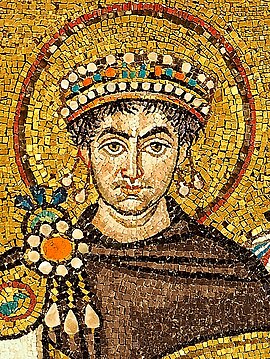
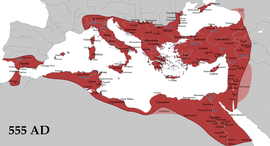
| Part of a series on the |
| Eastern Orthodox Church |
|---|
| |
| Overview |
Archbishopric of Justiniana Prima was a Christian autonomous Archbishopric with see in the city of Justiniana Prima and jurisdiction over the Late Roman Diocese of Dacia in central parts of the Southeastern Europe. [1]



The archdiocese was established in 535 AD by Emperor Justinian I, in his presumed home-town of Justiniana Prima (near present-day Lebane, in Southern Serbia).
The establishment is mentioned in Justinian's own Novel XI from 535, when he promotes the metropolitan to an archbishop, independent from the Archbishop of Thessalonica. [2] The very first archbishop of Justiniana Prima was Amincius, later marthirized in a raid by Cumans.[ citation needed ]
Its last mention is in 602, amid the Slav raids on the Balkans.
Its cathedral archiepiscopal see was at Justiniana Prima. According to Novella 11, issued in 535, the first Archbishop received canonical jurisdiction over the following Byzantine provinces, mainly on the territory of the Diocese of Dacia: [3]
But by 545, in the Novella 131, Macedonia Secunda was omitted. [3]
The Archbishopric of Ohrid was seen as a successor of the old archbishopric. Archbishop John IV, nephew of emperor Alexios I Komnenos, resurrected the title of Archbishop of Justiniana Prima in 1143 for his own use. [5]
It is one of the titular sees listed in the Annuario Pontificio . [6]
It has had the following incumbents, all of the archiepiscopal (intermediary) rank:
In Christian denominations, an archbishop is a bishop of higher rank or office. In most cases, such as the Catholic Church, there are many archbishops who either have jurisdiction over an ecclesiastical province in addition to their own archdiocese, or are otherwise granted a titular archbishopric. In others, such as the Lutheran Church of Sweden, the title is only borne by the leader of the denomination.

The Archbishopric of Ohrid, also known as the Bulgarian Archbishopric of Ohrid, originally called Archbishopric of Justiniana Prima and all Bulgaria, was an autocephalous Eastern Orthodox Church established following the Byzantine conquest of Bulgaria in 1018 by lowering the rank of the autocephalous Bulgarian Patriarchate due to its subjugation to the Byzantines. In 1767, the Archbishopric's autocephaly was abolished, and the Archbishopric was placed under the tutelage of the Patriarchate of Constantinople.

Patriarch of the West is one of the official titles of the Bishop of Rome, as patriarch and highest authority of the Latin Church.

The praetorian prefecture of Illyricum was one of four praetorian prefectures into which the Late Roman Empire was divided.
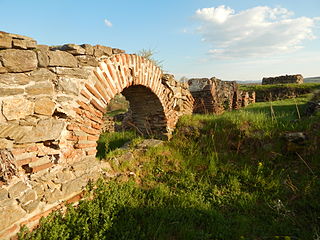
Justiniana Prima was an Eastern Roman city that existed from 535 to 615 CE, near modern Lebane in the Leskovac region, Serbia. It is currently an archaeological site. Founded by Emperor Justinian I (527-565), it was the metropolitan seat of the newly founded Archbishopric of Justiniana Prima, which became the main church administrative body of the central Dardania with jurisdiction from Praevalitana to Dacia Ripensis. Justinian Prima was originally designed to become the capital of the prefecture of Illyricum, but for reasons likely related with its status near the Roman frontiers of the 6th century CE, Thessaloniki was preferred. It was abandoned less than 100 years after its foundation.

Pannonia Secunda was one of the provinces of the Roman Empire. It was formed in 296 AD, during the reign of Emperor Diocletian. The capital of the province was Sirmium. Pannonia Secunda comprised parts of present-day Serbia, Croatia, and Bosnia and Herzegovina.

Ulpiana was an ancient Roman city located in what is today Kosovo. It was also named Justiniana Secunda (Latin: Iustiniana Secunda, Albanian: Justinianë Sekundë. Ulpiana is located in the municipality of Gračanica, 12 km southeast of Pristina. The Minicipium Ulpiana or Iustiniana Secunda was proclaimed an archaeological park under the permanent protection of Kosovo by the Kosova Council for Cultural Heritage in 2016. The archaeological park has an area of 161.10 hectares and a surrounding protection zone of 96.23 hectares. Ulpiana was among the largest settlements in the Balkans in late antiquity.

Dacia Ripensis was the name of a Roman province in the northern Balkan peninsula, immediately south of the Middle Danube. Its capital was Ratiaria. It was a district less urban than neighbouring Dacia Mediterranea and more militarized; "military camps and forts, rather than cities, were typical of the province". Besides Ratiaria, Oescus was the major settlement.

Dacia Mediterranea was a late antique Roman province, whose capital city was Serdica.
Eastern Orthodoxy is the primary Christian denomination in Serbia, representing 81% of the population as of 2022, followed traditionally by the majority of Serbs, and also Romanians and Vlachs, Montenegrins, Macedonians and Bulgarians living in Serbia. The dominant Eastern Orthodox church in Serbia is the Serbian Orthodox Church. Also, the Romanian Orthodox Church has its own Diocese of Dacia Felix that operates among Orthodox Romanians in Serbian Banat and the Timok Valley.

The Diocese of Dacia was a diocese of the later Roman Empire, in the area of modern western Bulgaria, central Serbia, Montenegro, Kosovo, northern Albania and northern North Macedonia. It was subordinate to the Praetorian prefecture of Illyricum. Its capital was at Serdica.

Praevalitana was a Late Roman province that existed between c. 284 and c. 600. It included parts of present-day Montenegro, Albania, and part of present-day Kosovo. Its capital city was Doclea, later Scodra.

Dardania was a Roman province in the Central Balkans, initially an unofficial region in Moesia (87–284), and then a province administratively part of the Diocese of Moesia (293–337). It was named after the tribe of the Dardani who inhabited the region in classical antiquity prior to the Roman conquest. During the late Imperial period the Dardanian territory was the homeland of many Roman emperors, notably Constantine the Great and Justinian I.

Much of the territory of the modern state of Serbia was part of the Roman Empire and later the Eastern Roman Empire. In particular, the region of Central Serbia was under Roman rule for about 800 years, starting from the 1st century BC, interrupted by the arrival of the Slavs into the Balkans during the 6th century, but continued after fall of the First Bulgarian Empire in the early 11th century and permanently ended with the rise of the Second Bulgarian Empire in the late 12th century. The territories were administratively divided into the provinces of Moesia, Pannonia and Dardania. Moesia Superior roughly corresponds to modern Serbia proper; Pannonia Inferior included the eastern part of Serbia proper; Dardania included the western part of Serbia proper. After its reconquest from the Bulgarians by Emperor Basil II in 1018, it was reorganized into the Theme of Bulgaria.

Christianity in Kosovo has a long-standing tradition dating to the Roman Empire. The entire Balkan region had been Christianized by the Roman, Byzantine, First Bulgarian Empire, Serbian Kingdom, Second Bulgarian Empire, and Serbian Empire till 13th century. After the Battle of Kosovo in 1389 until 1912, Kosovo was part of the Muslim Ottoman Empire, and a high level of Islamization occurred. During the time period after World War II, Kosovo was ruled by secular socialist authorities in the Socialist Federal Republic of Yugoslavia (SFRY). During that period, Kosovars became increasingly secularized. Today, 87% of Kosovo's population are from Muslim family backgrounds, most of whom are ethnic Albanians, but also including Slavic speakers and Turks.

Eparchy of Raška and Prizren is one of the oldest eparchies of the Serbian Orthodox Church, featuring the seat of the Serbian Orthodox Church, the Serbian Patriarchal Monastery of Peć, as well as Serbian Orthodox Monastery of Visoki Dečani, which together are part of the UNESCO World Heritage sites of Serbia.

Moesia Prima was a frontier province of the Late Roman Empire, situated in the central parts of present-day Serbia, along the south bank of the Danube River. Provincial capital was Viminacium, near modern Kostolac in Serbia).
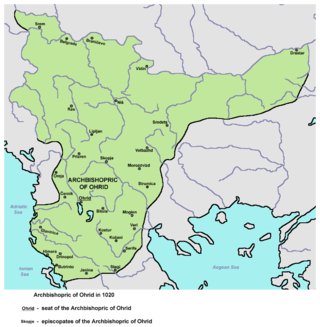
Eparchy of Lipljan, later known as the Eparchy of Gračanica or the Eparchy of Novo Brdo is one of the former historical Eastern Orthodox eparchies of Serbian Orthodox located in the central parts of Kosovo region. It is now part of Eparchy of Raška and Prizren. In older research, it was mistakenly identified as the bishopric of Ulpiana.
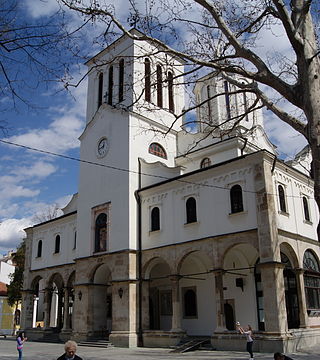
The Eparchy of Niš is an eparchy (diocese) of the Serbian Orthodox Church with its seat in Niš, in Serbia. It has jurisdiction over the south-eastern regions of Serbia. Since 2017, Serbian Orthodox Bishop of Niš is Arsenije Glavčić.

The Metropolitanate of Skopje is an Eastern Orthodox eparchy, formerly under the jurisdiction of the Orthodox Ohrid Archbishopric, an autonomous and canonical branch of the Serbian Orthodox Church in North Macedonia. Its seat is in Skopje. It is a metropolitan diocese of the Orthodox Ohrid Archbishopric, headed by Archbishop Jovan Vraniškovski of Ohrid, who is also styled Metropolitan of Skopje.